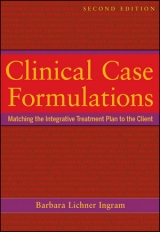
Clinical Case Formulations
John Wiley & Sons Inc (Verlag)
978-0-471-74314-9 (ISBN)
- Titel erscheint in neuer Auflage
- Artikel merken
A step-by-step model for individualized case conceptualization This innovative new guide addresses the essential question facing every therapist with a new client: How do I create a treatment plan that is the best match for my client? This unique resource provides a systematic method to integrate ideas, skills, and techniques from different theoretical approaches, empirical research, and clinical experience to create a case formulation that is tailor-made for the client. Clinical Case Formulations is divided into three parts: Getting Started--provides an overview that sets forth a framework for case formulation and data gathering. 28 Core Clinical Hypotheses--offers a meta-framework embracing all theories, orientations, and mental health intervention models and presents clinical hypotheses within seven categories: Biological Hypotheses; Crisis, Stressful Situations, and Transitions; Behavioral and Learning Models; Cognitive Models; Existential and Spiritual Models; Psychodynamic Models; and Social, Cultural, and Environmental Factors. These hypotheses are combined and integrated to develop a coherent conceptualization of the client's problems.
Steps to a Complete Case Formulation--provides a structured framework known as the Problem-Oriented Method (POM). Using the POM and integrating multiple hypotheses, the therapist learns how to think intelligently, critically, and creatively in order to develop a tailor-made treatment plan. A list of thirty-three standards for evaluating the application of this method is provided. With this practical guide you will learn to conceptualize your clients' needs in ways that lead to effective treatment plans while finding the tools for troubleshooting when interventions fail to produce expected benefits.
BARBARA LICHNER INGRAM, PHD, is Professor of Psychology at Pepperdine University.
Tables. Preface. Case Formulation Skills Can Be Systematically Taught. Treatment Quality Is Enhanced by Integrating Different Approaches. Empirical Validation Can Come from Clinical, Single-Case Methodology Not Just from Random Clinical Trials. We Need to Address the Needs of Culturally and Religiously Diverse Clients. We Need a System to Communicate More Effectively with Case Managers in Managed Care and Insurance Companies. Acknowledgments. Part I: Getting Started. 1. A Framework for Case Formulations. How Am I Going to Know What to Do? Core Clinical Hypotheses. The Problem-Oriented Method. Tasks and Processes of Case Formulation. The Learning Process. Suggested Readings. 2. Gathering Data. Data-Gathering Tasks. Intake Processes. Exploration of the Cognitive Domain. The Clinician as Objective Observer. Client History. Activities for Data Gathering. Homework Assignments as a Source of Data. Suggested Readings. Part II: Twenty-Eight Core Clinical Hypotheses. How to Approach the Hypotheses. 3. Biological Hypotheses. Key Ideas for B1 Biological Cause. When Is B1 a Good Match for Your Client? Treatment Planning for B1 Biological Cause. Integration of Hypotheses with B1 Biological Cause. Key Ideas for B2 Medical Interventions. When Is B2 a Good Match for Your Client? Treatment Planning for B2 Medical Interventions. Integration of Hypotheses with B2 Medical Interventions. Key Ideas for B3 Mind-Body Connections. When Is B3 a Good Match for your Client? Treatment Planning for B3 Mind-Body Connections. Integration of Hypotheses with B3 Mind-Body Connections. Suggested Readings. 4. Crisis, Stressful Situations, and Transitions. Key Ideas for CS1 Emergency. When Is CS1 a Good Match for Your Client? Treatment Planning for CS1 Emergency. Integration of Hypotheses with CS1 Emergency. Key Ideas for CS2 Situational Stressors. When Is CS2 a Good Match for Your Client? Treatment Planning for CS2 Situational Stressors. Integration of Hypotheses with CS2 Situational Stressors. Key Ideas for CS3 Developmental Transition. When Is CS3 a Good Match for Your Client? Treatment Planning for CS3 Developmental Transition. Integration of Hypotheses with CS3 Developmental Transition. Key Ideas for CS4 Loss and Bereavement. When Is CS4 a Good Match for Your Client? Treatment Planning for CS4 Loss and Bereavement. Integration of Hypotheses with CS4 Loss and Bereavement. Suggested Readings. 5. Behavioral and Learning Models. Key Ideas for BL1 Antecedents and Consequences. When Is BL1 a Good Match for Your Client? Treatment Planning for BL1 Antecedents and Consequences. Integration of Hypotheses with BL1 Antecedents and Consequences. Key Ideas for BL2 Conditioned Emotional Response. When Is BL2 a Good Match for Your Client? Treatment Planning for BL2 Conditioned Emotional Response. Integration of Hypotheses with BL2 Conditioned Emotional Response. Key Ideas for BL3 Skill Deficits or Lack of Competence. When Is BL3 a Good Match for Your Client? Treatment Planning for BL3 Skill Deficits or Lack of Competence. Integration of Hypotheses with BL3 Skill Deficits or Lack of Competence. Suggested Readings. 6. Cognitive Models. Key Ideas for C1 Utopian Expectations. When Is C1 a Good Match for Your Client? Treatment Planning for C1 Utopian Expectations. Integration of Hypotheses with C1 Utopian Expectations. Key Ideas for C2 Faulty Cognitive Map. When Is C2 a Good Match for Your Client? Treatment Planning for C2 Faulty Cognitive Map. Integration of Hypotheses with C2 Faulty Cognitive Map. Key Ideas for C3 Faulty Information Processing. When Is C3 a Good Match for Your Client? Treatment Planning for C3 Faulty Information Processing. Integration of Hypotheses with C3 Faulty Information Processing. Key Ideas for C4 Dysfunctional Self-Talk. When Is C4 a Good Match for Your Client? Treatment Planning for C4 Dysfunctional Self-Talk. Integration of Hypotheses with C4 Dysfunctional Self-Talk. Suggested Readings. 7. Existential and Spiritual Models. Key Ideas for ES1 Existential Issues. When Is ES1 a Good Match for Your Client? Treatment Planning for ES1 Existential Issues. Integration of Hypotheses with ES1 Existential Issues. Key Ideas for ES2 Avoiding Freedom and Responsibility. When Is ES2 a Good Match for Your Client? Treatment Planning for ES2 Avoiding Freedom and Responsibility. Integration of Hypotheses with ES2 Avoiding Freedom and Responsibility. Key Ideas for ES3 Spiritual Dimension. When Is ES3 a Good Match for Your Client? Treatment Planning for ES3 Spiritual Dimension. Integration of Hypotheses with ES3 Spiritual Dimension. Suggested Readings. 8. Psychodynamic Models. Key Ideas for P1 Internal Parts and Subpersonalities. When Is P1 a Good Match for Your Client? Treatment Planning for P1 Internal Parts and Subpersonalities. Integration of Hypotheses with P1 Internal Parts and Subpersonalities. Key Ideas for P2 Reenactment of Early Childhood Experiences. When Is P2 a Good Match for Your Client? Treatment Planning for P2 Reenactment of Early Childhood Experiences. Integration of Hypotheses with P2 Reenactment of Early Childhood Experiences. Key Ideas for P3 Immature Sense of Self and Conception of Others. When Is P3 a Good Match for Your Client?. Treatment Planning for P3 Immature Sense of Self and Conception of Others. Integration of Hypotheses with P3 Immature Sense of Self and Conception of Others. Key Ideas for P4 Unconscious Dynamics. When Is P4 a Good Match for Your Client? Treatment Planning for P4 Unconscious Dynamics. Integration of Hypotheses with P4 Unconscious Dynamics. Suggested Readings. 9. Social, Cultural, and Environmental Factors. Key Ideas for SCE1 Family System. When Is SCE1 a Good Match for Your Client? Treatment Planning for SCE1 Family System. Integration of Hypotheses with SCE1 Family System. Key Ideas for SCE2 Cultural Context. When Is SCE2 a Good Match for Your Client? Treatment Planning for SCE2 Cultural Context. Integration of Hypotheses with SCE2 Cultural Context. Key Ideas for SCE3 Social Support. When Is SCE3 a Good Match for Your Client? Treatment Planning and Integration of Hypotheses with SCE3 Social Support. Key Ideas for SCE4 Social Role Performance. When Is SCE4 a Good Match for Your Client? Treatment Planning for SCE4 Social Role Performance. Integration of Hypotheses with SCE4 Social Role Performance. Key Ideas for SCE5 Social Problem Is a Cause. When Is SCE5 a Good Match for Your Client? Treatment Planning for SCE5 Social Problem Is a Cause Integration of Hypotheses with SCE5 Social Problem Is a Cause. Key Ideas for SCE6 Social Role of Mental Patient. When Is SCE6 a Good Match for Your Client? Treatment Planning for SCE6 Social Role of Mental Patient. Integration of Hypotheses with SCE6 Social Role of Mental Patient. Key Ideas for SCE7 Environmental Factors. When Is SCE7 a Good Match for Your Client? Treatment Planning and Integration of Hypotheses with SCE7 Environmental Factors. Suggested Readings. 10. Using Clinical Hypotheses. Brainstorming. Applying and Testing Hypotheses. Selecting and Combining Best-Fit Hypotheses. Integrating Hypothesis Testing into the Clinical Interview. Integrating Psychodynamic Hypotheses. Part III: Steps to a Complete Case Formulation. 11. Problem Identification and Definition. Problem Identification. Problem Definition. Standards for Problem Definition. 12. Setting Outcome Goals. Benefits of Clearly Defined Future Goals. Helping Clients Define "Smart Outcomes". Outcome Goals for Case Formulations. Standards for Outcome Goals. 13. Presentation of the Database. Standards for Database. 14. A Coherent Integrative Assessment. Standards for Assessment. 15. The Treatment Plan. Standards for Plans. Appendixes. Appendix I: Forms for Clinical Case Formulations. Form I.A SOAPing a Problem. Form I.B Using the BASIC SID. Form I.C Life History Timeline. Form I.D American History Timeline. Form I.E Worksheet for Preparing Formulation. Form I.F Twenty-Eight Clinical Hypotheses to Use with Your Own Cases. Appendix II: Useful Charts. Chart II.A Twenty-Eight Core Clinical Hypotheses. Chart II.B Thirty-Three Standards for Evaluating Case Formulations. Chart II.C Mental Status Exam. Chart II.D Client History. Chart II.E Patient Impairment Lexicon. Chart II.F Problem Categories from Treatment Planning Manual. Chart II.G Domains of Functioning. Chart II.H Bar-On's Emotional Intelligence: Fifteen Competencies. Chart II.I Inventory of Needs. Chart II.J Outline for Multiproblem Case Formulation Report. Appendix III: Skill-Building Activities. Activity 1.1: Writing Your Baseline Case Formulation Report. Activity 2.1: Practice with the BASIC SID. Activity 2.2: Metamodel Practice. Activity 10.1: Brainstorm Hypotheses. Activity 10.2: Apply and Test Hypotheses with Case Vignettes. Activity 10.3: Provide Commentary for a Transcript. Activity 11.1: Using the BASIC SID for Preliminary Problem List. A Case for Practice: Maria. Activity 11.2: Is It a Problem Title or an Assessment Idea? Activity 11.3: Problem Definition from Your Preliminary List. Activity 12.1: Developing "Smart Outcomes". Activity 12.2: Is It a Process Goal or an Outcome Goal? Activity 12.3: Practice Writing Outcome Goals. Activity 13.1: Is It Subjective Data or Objective Data? Activity 13.2: Find the Assessment in the Subjective Section. Activity 13.3: Is It Objective Data or Assessment? Activity 14.1: Using a Three-Column Worksheet. Activity 14.2: Writing Your Assessment Discussion 569 Activity 15.1: Components of the Plan. Activity 15.2: Evaluation of a Complete Report. Appendix IV: Examples. Sample SOAP for Activity 1.1: Writing Your Baseline Case Formulation Report. Student's Case Formulation Report for His Own Problem (Data Changed to Protect Anonymity). Sample Answers for Activity 10.2: Apply and Test Hypotheses with Case Vignettes. Maria: A Sample Case Formulation Report. References. Author Index. Subject Index.
| Erscheint lt. Verlag | 21.7.2006 |
|---|---|
| Verlagsort | New York |
| Sprache | englisch |
| Maße | 180 x 251 mm |
| Gewicht | 1178 g |
| Einbandart | Paperback |
| Themenwelt | Geisteswissenschaften ► Psychologie |
| Medizin / Pharmazie ► Medizinische Fachgebiete | |
| Studium ► 2. Studienabschnitt (Klinik) ► Anamnese / Körperliche Untersuchung | |
| ISBN-10 | 0-471-74314-3 / 0471743143 |
| ISBN-13 | 978-0-471-74314-9 / 9780471743149 |
| Zustand | Neuware |
| Haben Sie eine Frage zum Produkt? |
aus dem Bereich



